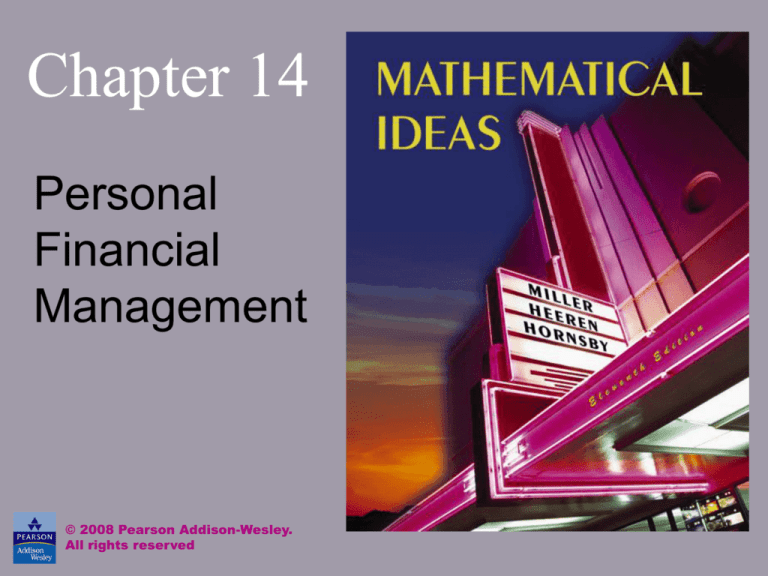
Chapter 14
Personal
Financial
Management
© 2008 Pearson Addison-Wesley.
All rights reserved
Chapter 14: Personal Financial
Management
14.1
14.2
14.3
14.4
The Time Value of Money
Installment Buying
Truth in Lending
The Costs and Advantages of Home
Ownership
14.5 Financial Investments
14-1-2
© 2008 Pearson Addison-Wesley. All rights reserved
Chapter 1
Section 14-1
The Time Value of Money
14-1-3
© 2008 Pearson Addison-Wesley. All rights reserved
The Time Value of Money
•
•
•
•
•
•
Interest
Simple Interest
Future Value and Present Value
Compound Interest
Effective Annual Yield
Inflation
14-1-4
© 2008 Pearson Addison-Wesley. All rights reserved
Interest
If we borrow an amount of money today, we will
repay a larger amount later. The increase in value is
known as interest. The money gains value over time.
The amount of a loan or a deposit is called the
principal. The interest is usually computed as a
percent of the principal. This percent is called the rate
of interest (or the interest rate, or simply the rate).
The rate of interest is assumed to be an annual rate
unless otherwise stated.
14-1-5
© 2008 Pearson Addison-Wesley. All rights reserved
Interest
Interest calculated only on principal is called simple
interest. Interest calculated on principal plus any
previously earned interest is called compound
interest.
14-1-6
© 2008 Pearson Addison-Wesley. All rights reserved
Simple Interest
If P = principal, r = annual interest rate, and
t = time (in years), then the simple interest I
is given by
I = Prt.
14-1-7
© 2008 Pearson Addison-Wesley. All rights reserved
Example: Finding Simple Interest
Find the simple interest paid to borrow $4800
for 6 months at 7%.
Solution
I = Prt = $4800(.07)(6/12) = $168.
6 months is 6/12 of a year.
14-1-8
© 2008 Pearson Addison-Wesley. All rights reserved
Future and Present Value
In the last example, the borrower would have to repay
$4800 + $168 = $4968.
The total amount repaid is called the maturity value
(or the value) of the loan. We will refer to it as the
future value, or future amount. The original
principal, denoted P, can also be thought of as present
value.
14-1-9
© 2008 Pearson Addison-Wesley. All rights reserved
Future Value for Simple Interest
If a principal P is borrowed at simple interest
for t years at an annual interest rate of r, then
the future value of the loan, denoted A, is
given by
A = P(1 + rt).
14-1-10
© 2008 Pearson Addison-Wesley. All rights reserved
Example: Future Value for Simple
Interest
Find the future value of $460 in 8 months, if the
annual interest rate is 12%.
Solution
8
A P 1 rt $460 1 .12 $496.80.
12
14-1-11
© 2008 Pearson Addison-Wesley. All rights reserved
Example: Present Value for Simple
Interest
If you can earn 6% interest, what lump sum must
be deposited now so that its value will be $3500
after 9 months?
Solution
A P 1 rt
9
3500 P 1 .06
12
$3500
P
$3349.28
1.045
© 2008 Pearson Addison-Wesley. All rights reserved
14-1-12
Compound Interest
Interest paid on principal plus interest is
called compound interest. After a certain
period, the interest earned so far is credited
(added) to the account, and the sum
(principal plus interest) then earns interest
during the next period.
14-1-13
© 2008 Pearson Addison-Wesley. All rights reserved
Compounding Period
Interest can be credited to an account at time
intervals other than 1 year. For example, it can
be done semiannually, quarterly, monthly, or
daily. This time interval is called the
compounding period (or the period).
14-1-14
© 2008 Pearson Addison-Wesley. All rights reserved
Future Value for Compound Interest
If P dollars are deposited at an annual interest
rate of r, compounded m times per year, and the
money is left on deposit for a total of n periods,
then the future value, A (the final amount on
deposit), is given by
n
r
A P 1 .
m
14-1-15
© 2008 Pearson Addison-Wesley. All rights reserved
Example: Future Value for Compound
Interest
Find the future value of $8560 at 4% compounded
quarterly for 8 years.
Solution
P = $8560, r = 4% = .04, m = 4. Over 8 years
n = 8m = 8(4) = 32.
n
r
.04
A P 1 $8560 1
4
m
32
$11,769.49.
14-1-16
© 2008 Pearson Addison-Wesley. All rights reserved
Example: Present Value for Compound
Interest
What amount must be deposited today, at 5%
compounded monthly, so that it will be $18,000 in
20 years?
Solution
.05
$18000 P 1
12
P
$18000
.05
1
12
240
240
$6635.60
14-1-17
© 2008 Pearson Addison-Wesley. All rights reserved
Effective Annual Yield
Savings institutions often give two quantities when
advertising the rates. The first, the actual
annualized interest rate, is the nominal rate (the
“stated” rate). The second quantity is the equivalent
rate that would produce the same final amount, or
future value, at the end of 1 year if the interest
being paid were simple rather than compound. This
is called the “effective rate,” or the effective
annual yield.
14-1-18
© 2008 Pearson Addison-Wesley. All rights reserved
Effective Annual Yield
A nominal interest rate of r, compounded m
times per year, is equivalent to an effective
annual yield of
m
r
Y 1 1.
m
14-1-19
© 2008 Pearson Addison-Wesley. All rights reserved
Example: Effective Annual Yield
What is the effective annual yield of an account
paying a nominal rate of 4.2%, compounded monthly?
Solution
12
.042
Y 1
1 .0428 4.28%
12
14-1-20
© 2008 Pearson Addison-Wesley. All rights reserved
Inflation
In terms of the equivalent number of goods or services
that a given amount of money will buy, it is normally
more today than it will be later. In this sense, the
money loses value over time. This periodic increase in
the cost of living is called inflation.
Unlike account values under interest compounding,
which make sudden jumps at certain points, price levels
tend to fluctuate gradually over time. It is appropriate,
for inflationary estimates, to use a formula for
continuous compounding.
14-1-21
© 2008 Pearson Addison-Wesley. All rights reserved
Inflation
Inflation in an economy usually is expressed as a
monthly or annual rate of price increases, estimated by
government agencies in a systematic way. In the
United States, the Bureau of Labor Statistics publishes
consumer price index (CPI) figures, which reflect the
prices of certain items purchased by large numbers of
people (see table on page 862 of the text).
14-1-22
© 2008 Pearson Addison-Wesley. All rights reserved
Future Value for Continuous
Compounding
If an initial deposit of P dollars earns
continuously compounded interest at an
annual rate r for a period of t years, then the
future value, A is given by
A Pe .
rt
14-1-23
© 2008 Pearson Addison-Wesley. All rights reserved
Example:
Suppose that a cup of your favorite coffee is
$1.25. If the inflation rate persists at 2% over
time, find the approximate cost of the coffee
in 25 years.
Solution
A Pe $2.25e
rt
(.02)(25)
$3.71
The coffee will cost about $3.71.
14-1-24
© 2008 Pearson Addison-Wesley. All rights reserved
Inflation Proportion
For a consumer product or service subject to
average inflation,
Price in year A CPI in year A
Price in year B CPI in year B
14-1-25
© 2008 Pearson Addison-Wesley. All rights reserved
Example: Inflation
If your mother paid $3,000 in tuition in 1980 at the
same college that you will be attending and paying
$9,300 in 2005, compare the school’s tuition increase
to inflation over that same period of time.
Solution
Let x represent what we expect the tuition to be in
2005 if it had increased at the average rate since 1980.
Price in year 2005 CPI in year 2005
Price in year 1980 CPI in year 1980
© 2008 Pearson Addison-Wesley. All rights reserved
14-1-26
Example: Inflation
Solution (continued)
x
195.3
$3000 82.4
x $7110.44.
Now compare with the actual 2005 tuition.
$9300
1.30
$7128.64
Tuition at the school increased approximately 30%
more than the average CPI-U rate.
14-1-27
© 2008 Pearson Addison-Wesley. All rights reserved
Rule of 70
An estimation of the years to double, which is the
number of years it takes for the general level of
prices to double for a given annual rate of inflation,
is given by
70
years to double
.
annual inflation rate
14-1-28
© 2008 Pearson Addison-Wesley. All rights reserved
Example:
Estimate the number of years to double for an annual
inflation rate of 2.1%
Solution
70
Years to double
33.33
2.1
With an inflation rate of 2.1%, prices would double
in about 34 years.
14-1-29
© 2008 Pearson Addison-Wesley. All rights reserved






